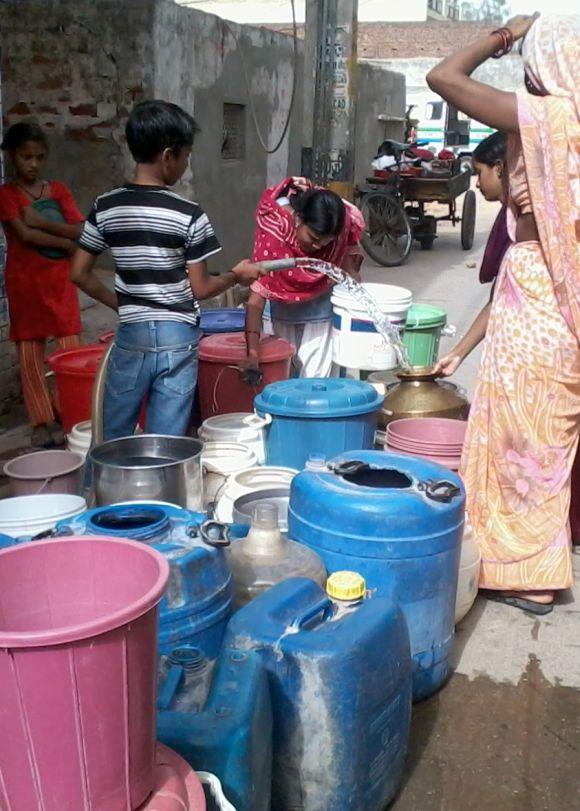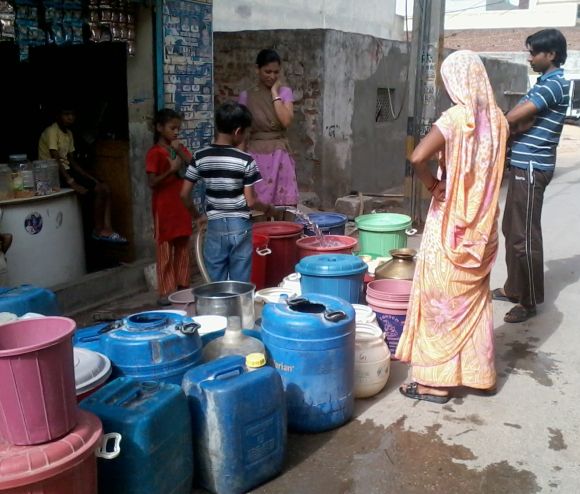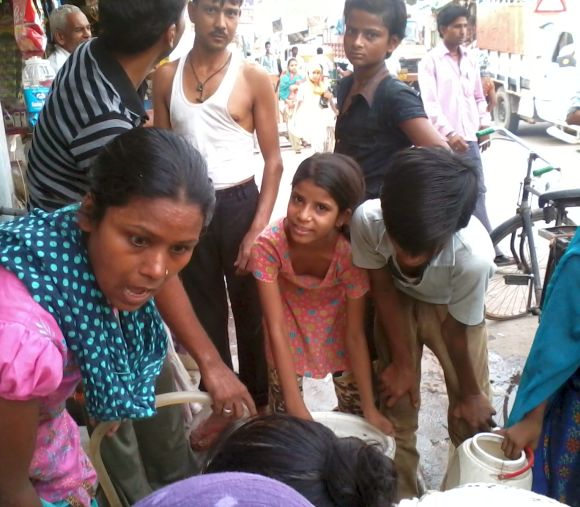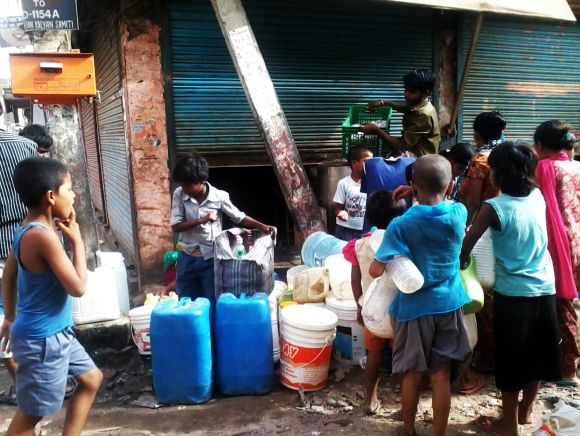 | « Back to article | Print this article |
'No water shortage in Delhi, only discriminatory supply'
An audit report of the Delhi Jal Board states that failure in timely construction of underground reservoirs and booster pumping stations has resulted in an unequal distribution of water. Priyanka reports
In his mid 70s, Dhanpal watches over a child with a water pipe in his hands. A dozen people carrying plastic containers of all sizes crowd around him waiting anxiously for their turn to fill up.
Water is a scare commodity for these residents of Sangam Vihar, probably the biggest segregation of unauthorised houses in Delhi.
The past few weeks have witnessed an unprecedented hue and cry about water shortage in the capital. While residents, mainly in the southern and northern parts of Delhi, have complained of an acute shortage in water supply, this scarcity has not been evenly experienced by all residents across.
Dhanpal, a driver, owns some 50-odd rooms in gali no.1 of Sangam Vihar. His eight brothers, who are all residents of the same gali, also own rooms that are rent out to a family of three-four members. Most of these tenants work as vendors and laborers in adjoining Govindpuri and Kalkaji.
Dhanpal pays Rs 5,000 to a private contractor for two hours of uninterrupted water supply.
"Each one of them (his tenants) will store around 700 to 800 liters of water, which will be used for the next 4-5 days," Dhanpal explains. "There is no water here, we are hit by hard times," he says.
Click NEXT to read further...
'We have to depend on private suppliers for water'
Across the gali, another group surrounds a water tap; the flow of water is thinning.
Mohammad Sikander is here with his family of eight to fetch water. A tailor, he has not been able to go to work for months.
"We pay 150 rupees to the Delhi Jal Board every month, but still there is no water here. We have to depend on private suppliers, who take additional money," he complains.
Those in the queue say that they have to wait for hours for their turn.
"We stand in the line from 3am, and only then can we hope to get water in the morning," he says.
"At times, people from as far as gali no.16 come to fetch water here as it is not available at any other place," adds Sikander.
Sangam Vihar has about 1.5 lakh registered voters.
However, it is not the same in nearby Govindpuri. Shankar, a shopkeeper says, "Even when there was water scarcity, we used to get a regular supply of water."
An audit report of the Delhi Jal Board admits that there is an inequitable distribution of water in different parts of Delhi. The report further states that the main reason for this is that the Delhi Jal Board has failed to timely complete construction of underground reservoirs and booster pumping stations in West, North-West and South-West, which has resulted in an unequal distribution of water.
Click NEXT to read further...
'Water supply unequal and discriminatory'
If experts are to be believed, the distribution of water is not only unequal, it is discriminatory.
Ravi Agrawal, who works with a Delhi-based NGO, Toxics Link, has been studying the reasons for water shortage in the capital. He says most of the areas within the Delhi region that come under the NDMC, mainly the VVIP colonies and parts of central Delhi, rarely face water shortages.
"There is a distribution bias," he starts to explain. "Most of the time, there is water shortage in and around unauthorised colonies or areas such as Chattarpur and Mehrauli."
"Most of the areas that experience water shortages come under the MCD," he says. "And the private tankers then come in to fulfil the shortage."
A resident of Mehrauli, Vinod Jain had filed a PIL against the Delhi Jal Board in 2000, complaining about scarce amount of water available to Mehrauli region and its adjoining areas.
"All we get is 29 liters per person per day, which is very less as compared to what is supplied to the cantonment areas. The situation is even worse in villages in the outskirts of south Delhi," he complains.
However, this does not explain shortage of water supply in many upmarket colonies such as Vasant Vihar and Gulmohar Park, both in south Delhi. Agrawal argues that most of the houses in these areas are big and have borewells, and the residents employ electric motors to draw underground water.
Click NEXT to read further...
'40 per cent of total water supply lost due to leakages'
"Most of the time, it is a competition for water, and since everyone has motors to draw water, some are obviously left high and dry," says Jain.
Another reason often attributed to the shortage of water supply in upmarket areas is that there are leakages in water supply lines.
The audit report of Delhi Jal Board also asserts that about 40 per cent of the total water supply is lost due to leakages. It also says that the 'system of leakage detection and management is inefficient'.
Furthermore, the audit report also says that about 41 per cent of the consumers who do not have meters installed were supplied with water. It resulted in a net loss of 1990.54 crores in 2006-07 to Delhi Jal Board.
However, both Agrawal and Vinod Jain are of the opinion that Delhi is not that parched for water.
In fact, Agrawal points out a recent exercise in an upmarket colony where all the residents had shut down their electric motors for some time. As a result, almost all residents were able to get water supply.
"We are not conscious about usage of water supply, and by using electric motors directly on borewells, the residents are deriving water directly from the groundwater reservoirs," says Agrawal.
"There is a tendency of over consumption. We must utilise water efficiently," he adds.
Click NEXT to read further...
'40 to 50 per cent of the water never reaches people'
It further raises the question: how long can we depend on groundwater resources alone? As experts have time and again pointed out the groundwater table is already depleting.
"We have to also explore surface water resources, such as building reservoirs. We should be serious about rain water harvesting and there should be a formal policy on it," Agrawal argues.
"Though Delhi is hugely dependent on the river Ganga for its water, why have we completely left out river Yamuna? It is a big source of surface water for us," he says.
Activist Manoj Misra has been working on Saving Yamuna campaign since 2007 in the city.
"We do not think that with Delhi Jal Board claiming to be supplying 50 gallons of water per person, there is any crisis in terms of availability of water. But yet, there is scarcity in parts of Delhi, mainly the north and south," says Misra.
He blames it on gross mismanagement and says that nearly 40-50 per cent of the water never reaches people.
"First of all, people must understand that there is actually no crisis in terms of water that is available. Also, there is a general observation that the more water you have, the more you tend to waste," he says.
He explains that river Yamuna even today meets almost 70 per cent of the demands of the city, and hence it is important that the river is revived.
"The river must be insured its natural flow," he says. "It will not only help in meeting the water needs, but will also recharge the groundwater aquifers," adds Misra.
TOP photo features of the week
Click on MORE to see another set of PHOTO features...





